NDVI stands for "Normalized Difference Vegetation Index". NRG stands for "Near-infrared / Red / Green". NDVI and NRG are both ways to visualize the amounts of infrared and other wavelengths of light reflected from vegetation. Because both these methods compare ratios of blue and red light absorbed versus green and IR light reflected, they can be used to evaluate the health of vegetation. It's a snapshot of how much photosynthesis is happening. This is helpful in assessing vegetative health or stress. (Read more here: https://www.agronomy.org/publications/jeq/articles/36/3/832) ## Do-It-Yourself These techniques for vegetation analysis were developed for satellite imagery, but at Public Lab, we've been working a lot on capturing infrared imagery using our DIY [near-infrared camera](/wiki/near-infrared-camera) setup, and combining it with visible bands to produce NDVI images such as the one above. ## What these images mean What exactly are these images we're trying to make? What do they tell us about vegetation, and why? These diagrams should help to understand what it is we're doing and why these are good ways to analyze plant life. ## The NDVI equation [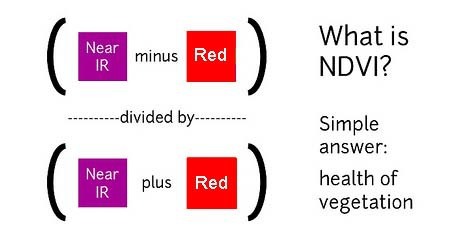](/i/44723) **NDVI = (Near Infrared - Red)/(Near Infrared + Red)** NDVI is a ratio which tries to emphasize photosynthesis while filtering out sun glare. The above equation is run for every pixel, using source data from an infrared photo and a visible light photo, like this pair: [](https://publiclab.org/system/images/photos/000/021/771/original/5390895115_c9d4d38fec_o.jpg) The result can be false-colored to make the high-photosynthesis areas more clear, and used to examine where plants are and how healthy they are. [](https://publiclab.org/system/images/photos/000/021/770/original/PetVISNDVIcomp.png) _Figure above: Normal color photo (right) and normalized difference vegetation index (NDVI) image (left). NDVI image was derived from two color channels in a single photo taken with a camera modified with a special infrared filter. Note that tree trunks, brown grass, and rocks have very low NDVI values because they are not photosynthetic. Healthy plants typically have NDVI values between 0.1 and 0.9. -- @cfastie_ ### Activities Here are a range of activities you can do to produce and interpret your own NDVI imagery, whether downloaded from a satellite imagery provider or [collected yourself using a DIY technique](/wiki/multispectral-imaging) [activities:ndvi] ****   Most DIY converted cameras today (those from Public Lab) use RGN instead of NRG, so the blue channel represents infrared instead of the red channel. That looks like this: [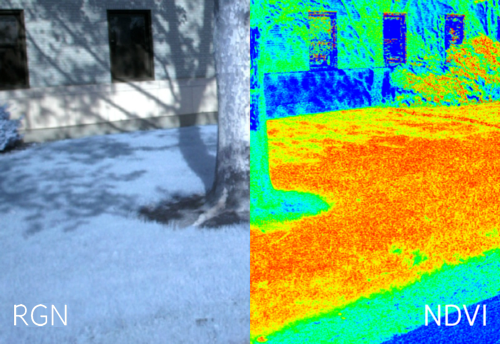](/i/45468?s=o) **** ## NRG imagery Some people are also interested in producing NRG imagery (like the below image), where `Near-Infrared, Red, and Green` are used to compose a picture instead of the usual `Red, Green, and Blue`. [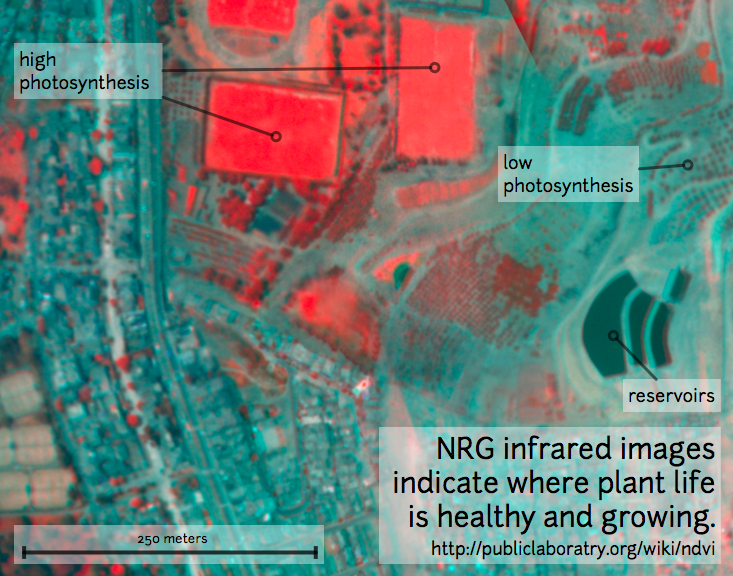](/i/25064) This diagram explains the swapping, which allows us to 'see' infrared as if it were a normal color: [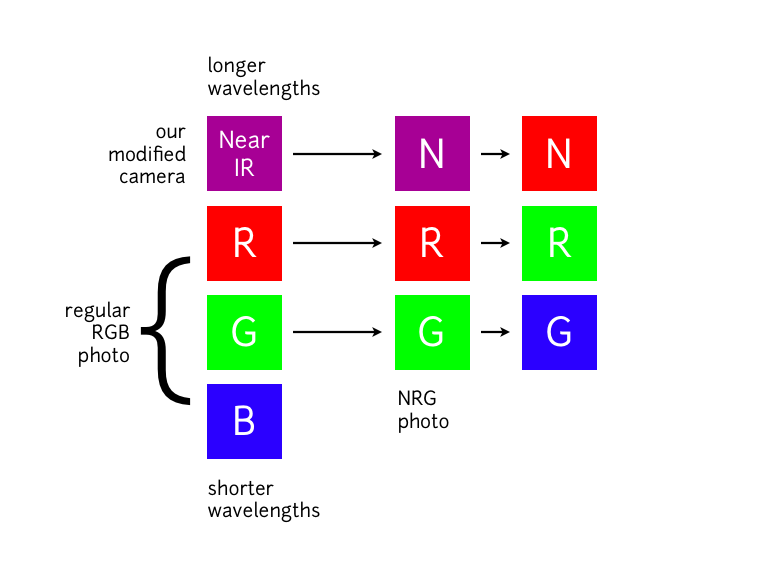](/i/25063) **In NRG images, the deeper and clearer the red color, the denser and healthier the vegetation (more or less).** ### Questions [questions:ndvi] ### Other examples of DIY NDVI imaging From around the internet: Begin watching at 2 minutes to see the resulting imagery: *This topic is part of the [Grassroots Mapping Curriculum](/wiki/mapping-curriculum) series.* **** [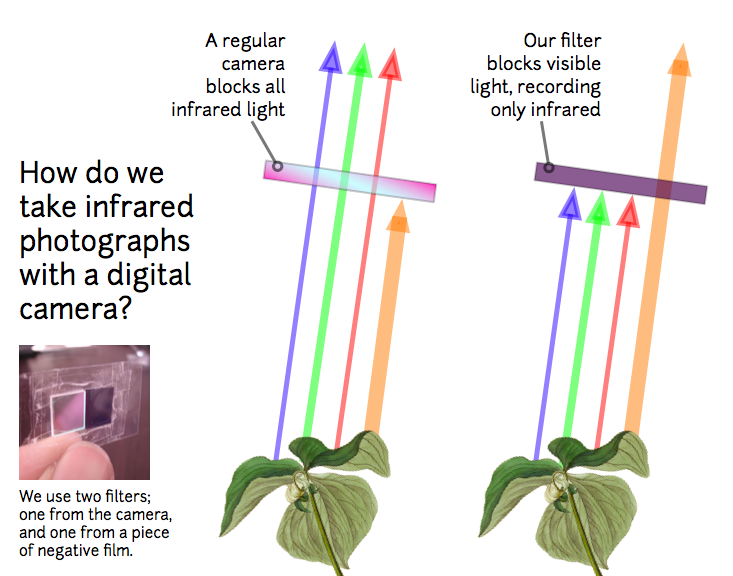](/i/25066) [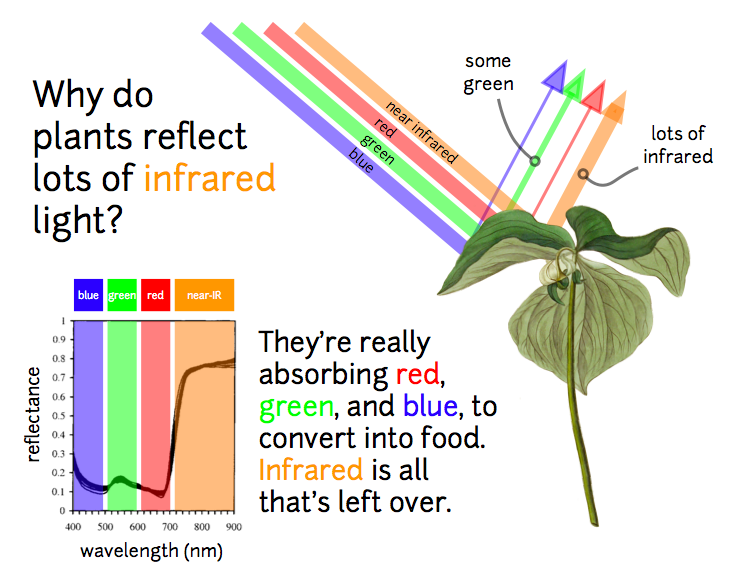](/i/25065) ...
| Author | Comment | Last activity | Moderation | ||
|---|---|---|---|---|---|
| warren | "Hi! The Mobius can be used as a webcam, and a converted lens is available in the store: https://publiclab.myshopify.com/collections/diy-infrared-ph..." | Read more » | over 7 years ago | |||
| msfisher | "Do you know if there is a place I can buy a usb camera already with the Wratten 25A, I got the original infragram which uses the blue channel, but ..." | Read more » | over 7 years ago | |||
| patcoyle | "Interesting work. Thanks, Chris. " | Read more » | over 7 years ago | |||
| cfastie | "Setting a custom white balance on the Mobius camera can be done numerically. Determining which numbers to use requires trial and error and subjecti..." | Read more » | over 7 years ago | |||
| suman | "Dear Cfastie, Very informative. Thanks for posting. I was interested to know, which method is more preferred and accurate, whi..." | Read more » | over 7 years ago | |||
| cfastie | "Although the full range of near infrared transmission of the Rosco 19 filter has not been measured (by anyone we know about ), we are not without t..." | Read more » | over 7 years ago | |||
| suman | "Dear Chris, After some thoughts , i believe Rosco 19 is not accurate enough, i mean it collects only few spectrum of infrared. If ..." | Read more » | over 7 years ago | |||
| suman | "Dear Chris, Thank you so much for your reply. So the accuracy relies on the custom white balance settings. I found one interesting..." | Read more » | over 7 years ago | |||
| cfastie | "The spectral response graphs supplied by Rosco don't go past 740 nm. So we are assuming that there is some transmission farther into the near infra..." | Read more » | over 7 years ago | |||
| warren | "Yeah - so one idea behind the methods pages is to try to list out some of the "challenges" or next steps that'd be needed, and some of the remainin..." | Read more » | over 7 years ago | |||
| cfastie | "I guess the method would be deriving NDVI from inexpensive sensors (not cameras) operated by a microcontroller. There might be a better sensor (or ..." | Read more » | over 7 years ago | |||
| suman | "Dear Chris & Mathew, Does the Rosco 19 Fire allows the light spectrum from only 560 to 740 nm range? The Wratten 25 A transm..." | Read more » | over 7 years ago | |||
| warren | "Wow, this is super! Thanks, Chris! Do you think as more info comes together around this device (like more posts, questions, etc) we might post it o..." | Read more » | over 7 years ago | |||
| cfastie | "I've made a couple of those I2C hubs and they are very handy. They're fun to make too. I now put a little super glue between the header plastic bef..." | Read more » | over 7 years ago | |||
| xose | "I can see your tiny forked I2C hub around the prototype ;) Amazind device!! " | Read more » | over 7 years ago | |||
| suman | "Dear Warren, I am currently looking some literatures on Image Vignetting Correction. I will definately post back after i come ..." | Read more » | over 7 years ago | |||
| warren | "Ah, i've just learned that I didn't know the definition of vignetting. But I do now -- apologies for mixing this up! I haven't heard anything about..." | Read more » | over 7 years ago | |||
| suman | "Dear Warren, I checked about the lens vignetting correction under the tag Lens-distortion as you mentioned. However, i didn't ..." | Read more » | over 7 years ago | |||
| suman | "Thanks for your prompt response warren.....highly appreciable.... Cheers " | Read more » | over 7 years ago | |||
| suman | "Thanks for your prompt response warren.....highly appreciable.... Cheers " | Read more » | over 7 years ago | |||
| warren | "There are a few different approaches to this too, but one which definitely works is documented alongside an in-progress web-based approach, both un..." | Read more » | over 7 years ago | |||
| suman | "Thanks for your response warren and Chris...I highly appreciate it..I was also interested to know about the vignetting effect and how public labs i..." | Read more » | over 7 years ago | |||
| cfastie | "Do you think i need the targets of known spectral reflectivity in the same bands that will be used to compute NDVI or it can be tested with any mat..." | Read more » | over 7 years ago | |||
| warren | "Hi -- well, there may be methods like that; just to put in another idea, although you probably won't want to do it; Dorn Cox from Farm Hack has act..." | Read more » | over 7 years ago |